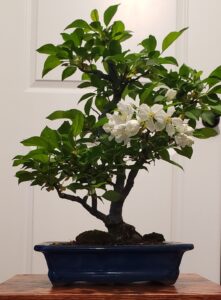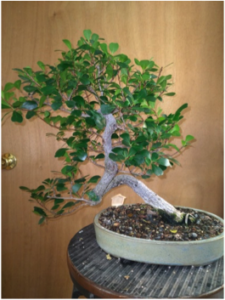
Crabapple
Crabapples are small deciduous trees or shrubs with oval or elliptic leaves that can also be lobed in some cases and grow in an alternating pattern. They are native to northern temperate zones and are frost tolerant. The most popular crabapple species for bonsai are Malus halliana, Malus x zumi, Malus toringo, Malus sylvestris, Malus floribunda, Malus baccata, and Malus cerasifera, but several others can be used.
Crab apple bonsai trees are a captivating choice for bonsai enthusiasts. Their delicate spring flowers and vibrant autumn fruits make them a stunning addition to any bonsai collection. Crab apple bonsai trees produce small, intricate flowers in various colors, such as pink, white, or red. These blossoms create a breathtaking sight when they cover the tree’s branches. In autumn, crab apples transform into vibrant, miniature fruits that add a pop of color to the bonsai. Depending on the variety, they can range from green to yellow, orange, or even deep red.
The crabapple needs a lot of sunlight and aeration, so place the tree outside in full sun. However, it does not like strong heat, so don’t place it in front of a wall that heats up during the day, for example. The tree is frost-hardy, but crabapples planted in bonsai containers should be protected from strong frosts for safety.
The crabapple needs a lot of water during the growing season and must not dry out, especially when it flowers or produces fruit. Those will be dropped if sufficient water is not provided in time. In winter, the apple must be kept slightly moist. Apples don’t like acidic water and soil, so in most cases, tap water is just fine for watering.
Apply solid organic fertilizer every four weeks or a balanced liquid fertilizer weekly during the growing season. Do not use a very nitrogen-rich fertilizer while the tree flowers or develops fruit, as this would encourage the tree to grow strongly instead of producing fruit. Always apply liquid fertilizer on moist soil.
Prune the crab apple in late autumn after the leaves have fallen. Then, flower and leaf buds are easily identified, and you cannot cut off all flower buds. During the growing season, trim new shoots to one or two leaves when they grow too long and thicken too much. If the tree produces a significant number of fruit, remove all but one from each cluster to not weaken the tree. Younger branches and twigs can be wired, but older ones are quite brittle, and you better shape them with guy wires.
Sources



